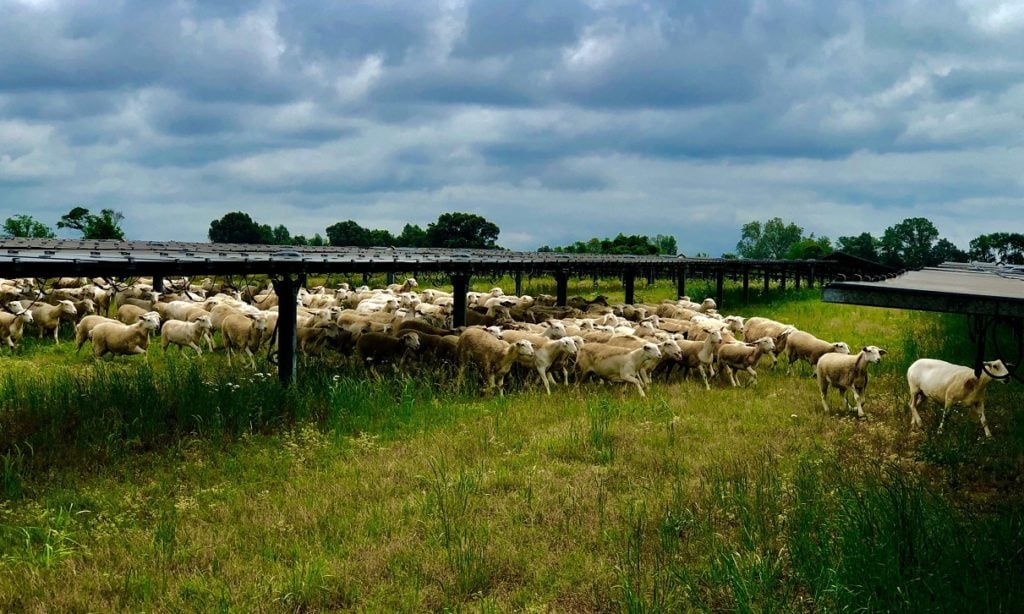
As 2023 comes to an end, PV Tech is looking back at some of the most interesting and prominent themes to emerge from our coverage of the solar industry this year. In this article, we will be examining the rising interest in agrivoltaics, also known as Agrisolar or AgriPV, the practice of pairing solar PV deployments with farming on the same land.
Into the big time
In November, the European Commission approved a €1.7 billion (US$1.8 billion) investment scheme to support the development of agrivoltaics in Italy. In total the funding will back just over 1GW of agrivoltaic projects, to be awarded through a bidding process that will build on one of the most active agrivoltaics markets in the world.
Try Premium for just $1
- Full premium access for the first month at only $1
- Converts to an annual rate after 30 days unless cancelled
- Cancel anytime during the trial period
Premium Benefits
- Expert industry analysis and interviews
- Digital access to PV Tech Power journal
- Exclusive event discounts
Or get the full Premium subscription right away
Or continue reading this article for free
This funding came around a month after the EU’s Joint Research Centre (JRC) published findings which said that the bloc could deploy 944GW of agrivoltaics on just 1% of its utilised farmland, assuming an average installation rate of 0.6MW per hectare. The JRC made a point of emphasising that agrivoltaics sits at the crossroads of the EU’s renewable energy and agricultural goals; the centre’s Solar Energy Strategy calls for 720GW of deployed solar by 2030, and its Common Agricultural Policy simultaneously calls for member states to implement agricultural strategies to preserve the agriculture and farming industry.
In conversation with PV Tech Power at the start of this year, chief commercial officer at US solar developer Silicon Ranch Matt Beasley said that: “This industry is going to be responsible for millions of acres of land over the next ten years and we have a responsibility to maintain that land, if not improve it for future generations.”
In the same conversation, he called for the solar industry to realign its perception of land and land use as it relates to solar development, to consider it as a valued resource in the same way as energy output or capacity.
What the JRC research shows, along with the subsequent funding allocation in Italy, is a serious consideration of agrivoltaics’ potential from legislators in Europe. Private industry is perhaps less likely than government to take a broad-perspective look at the confluence of solar and farming and the dual-use solution it provides for land.
Speaking of big money, French fossil fuels giant TotalEnergies bought Ombrea, a compatriot agrivoltaics specialist developer in September for an undisclosed sum, and the purchase represents TotalEnergies’ ambition to develop 1.5GW of agrivoltaics.
As with the EU’s publication of the JRC’s research, the significance for agrivoltaics here comes from association; TotalEnergies is one of the largest energy companies in the world and was the number one PV developer in the world over the last year by capacity volume according to Mercom Capital Group. Its decision to back agrivoltaics and establish an ‘agrivoltaics division’ – as per its announcement – speaks to the place that the technology is taking in the mainstream of the PV industry.
Versatile options
Elsewhere throughout the year, PV Tech Premium has examined agrivoltaics deployments from a number of angles.
Back in September, we published a feature looking into the emerging field of urban or rooftop agrivoltaics. As cities and urban populations grow, food supply will need to grow with them and locally-sourced food and energy are less carbon intensive than their counterparts sourced far overseas. Simultaneously, rooftop solar, whether it’s residential, commercial or industrial, is on the rise the world over.
PV Tech Premium spoke with Jennifer Bousellot, assistant professor of urban horticulture at the University of Colorado, who said that she saw the potential for rooftop agrivoltaics to produce food and energy, as well as saving water, all in the same place, three of the key renewable resources needed for a post-climate change world.
The main barrier to rooftop agrivoltaics – as with regular ground-mount agrivoltaics – is the increased cost of the system compared with a standard configuration. In the case of rooftop systems the price of ‘greening’ a roof and installing panels is often significant and the owners of the buildings most suited to installations – for instance municipal buildings, businesses and blocks of flats – often don’t want to pay the upfront cost.
What it takes, Bousellot told PV Tech Premium, will be a large company or government to commit to urban or rooftop agrivoltaics to allow it to break through to the mainstream like its utility-sale counterpart.
Technically speaking
Around a similar time, we also interviewed US agrivoltaics developer Bluewave about the lessons that the growth in agrivoltaics can teach the wider solar industry.
First among these was construction methods, wherein Bluewave tested multiple options and configurations to respond to the specificities of their Rockport agrivoltaic project in Maine, which is co-located with a blueberry farm.
The company trialled different module configurations and technologies, and found that for the greatest generation over a restricted agrivoltaic area, bifacial panels were preferable, culminating in the encouraging assessment that: “Solar construction is not necessarily the death knell for blueberries”.
This intersects interestingly with some research from July, published in the Progress in Photovoltaics journal, which examined different technical configurations for agrivoltaic projects in Europe. Researchers modelled three configurations: monofacial fixed-tilt modules suspended above agriculture, monofacial single-axis modules fitted with trackers that alter their angle throughout the day, and vertical bifacial modules set in fence-like rows.
Of these, both single-axis tracker modules and vertically-mounted bifacial ones offered greater irradiance and energy harvesting than fixed-tilt modules, as well as greater land usage for crops as the fixed tilt modules cast large, static shade over the ground. The researchers found that, as an average across Europe where agrivoltaics potential varies substantially, the optimum deployment of solar panels over land area was 30W per metre squared of capacity density, as it allowed around 80% of the land to still be usable for crops.
Solar developers, governments and industries should be seeking the most beneficial and sustainable practices for the energy transition. Going into 2024, the multi-faceted benefits and the global attention it’s received mean that we expect agrivoltaics to move even more towards centre stage in the solar industry and offer increased diversity of deployments.






